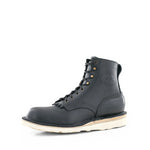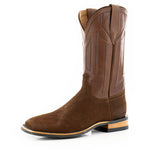How to Waterproof Winter Boots: Stay Dry in the Cold
Winter boots made using leather need to be treated with a leather preservative such as leather oil or wax that makes the leather water-resistant while still allowing the material to breathe.
I like treating my boots the day I get them, and I make cleaning my boots and treating them with oil a regular process.
Waterproofing your winter boots doesn’t just prevent water from getting in—it will prolong the lifespan of your boots. Here’s how you get it done.
What You’ll Need to Waterproof Your Winter Boots

Luckily, there aren't many items you’ll need to hand to waterproof your winter boots. Once you’ve got everything together, the important thing is to use them properly and use them regularly.
- Leather oil
- Cleaning brush
- Dry, clean microfiber cloths
When it comes to leather oil, there’s no better product than Obenauf's leather oil. Leather is a breathable material that needs excellent care, and Obenauf’s has all the natural oils your boots need to stay nourished and conditioned.
Thanks to the inclusion of beeswax and propolis (propolis is a resin-like substance made by bees before you ask), Obenauf’s oil is fantastic for keeping your boots healthy and water-resistant.
We offer a free bottle of Obenauf’s oil if you sign up for our email list, so make sure to sign up now and take advantage of that.
Waterproof Winter Boots in 3 Easy Steps

Applying any form of waterproofing to your winter boots should be part of your cleaning routine as it maintains and prolongs their lifespan.
Whenever your boots get muddy or wet, the natural oils slowly start to degrade, so it’s essential to give them a monthly clean and condition.
Before you begin, remove the laces from your boots to ensure you can reach every part of the upper. Waterproofing only works if you’ve oiled all the hard-to-reach areas, and that’s especially true of the tongue and eyelet area.
Step 1: Start With Clean, Dry Boots

If you’re waterproofing new winter boots, you’ll be able to skip this part, though it’s worth mentioning that even brand-new boots will need conditioning to make them waterproof.
You'll need to ensure your worn-in winter boots are entirely free of mud or debris before applying Obenauf’s oil. Use a leather cleaning brush to clean off every bit of dirt, and then give them a wipe down a clean microfiber cloth.
Warm water and some saddle soap is fine for removing dirt from leather and won’t harm your boots. Once your boots are clean, you’ll have to let them dry out naturally before moving on.
Step 2: Apply the Leather Oil

Once clean and dry, it’s time to apply the leather oil to your boots. Obenauf’s leather oil comes with an applicator ball fitted to the inside of the lid, making it easy to apply in small amounts.
You’ll also find a microfiber cloth useful here, as you can apply a small amount to the fabric and get to the areas of your boot that need closer attention. For the tongue area and any area with stitching, using your finger to dab on the oil will ensure you don’t miss any of the leather.
Only apply the oil to the outside of your boots. The trick is to use small amounts, working your way over the boots. Leather oil will darken your boots, sometimes up to several shades darker, but provided you’ve applied the oil evenly, you won’t notice any patchy areas.
Step 3: Buff Up and Check For Missed Areas.

Once you’ve finished applying the oil, you’ll have to leave them to dry. The oil will take time to soak into the pores of the leather and won’t weatherproof your boots until it has thoroughly soaked in.
After your boots have dried, you should give them an inspection. At this point, you’ll be able to see if you’ve accidentally missed applying oil to any of the leather.
Lighter patches, especially around seams, will need another application of oil. This isn’t only to make your boots look better; the lighter areas may not be waterproof, so you should always ensure every part of the leather is evenly coated.
Once satisfied, you can buff the leather using a brush or chamois. Keeping your boots in top condition will significantly affect their lifespan, and cleaning and waterproofing should be a part of your monthly routine.
With Obenauf’s Boot Care package, you’ll have everything you need to keep your boots healthy, soft, and waterproof. Once you’ve applied the oil and buffed up your boots, a spray with Pro-Tex water and stain remover will add the final layer of protection you’ll need.
We’re so confident in Obenauf’s leather oil that anyone signing up for our information-packed email list gets a complimentary bottle of oil in your package. Our deep-dive Youtube guide into oiling leather boots shows how important it is to stay consistent, care for your boots, and reap the rewards for years to come.
Finding a Consistent Routine
Winter boots must be cared for if you’re dealing with harsh weather, and waterproofing once a month will keep your boots strong and your feet dry.
We recommend Obenauf's leather oil for one straightforward reason—it’s one of the best leather oils in production. Following the simple steps above, your boots will stay nourished and waterproof. Leather that’s oiled will also stay pliable, making your boots feel much more comfortable.
Take time every month to clean and oil your boots. Waterproofing will prevent leather boots from degrading. Until you’ve waterproofed them, they’re not really winter boots. They’re just boots you wear in winter—and there’s a difference.
FAQs
Do winter boots need to be waterproofed?
If you’re wearing your winter boots outside, you’ll have to waterproof them to ensure they stay in top condition. It’s less vital if they’ll only be worn indoors, although the additional oil will keep them supple and the leather in better shape, which prolongs their lifespan considerably. Ideally, you should waterproof your winter boots monthly.
What should I use to waterproof my boots?
Several excellent options are available to waterproof your boots, ranging from waxes, such as beeswax, to leather oils and creams, such as lanolin. More modern waterproofing methods, such as waterproof sprays, are easily applied and are a great way to waterproof your boots quickly. Your choice can be determined by the type of materials your boots are made of.
Can you make non-waterproof boots waterproof?
Most leather boots are non-waterproof until treated using leather oil or wax and will need regular treatments to remain waterproof. It’s easy to waterproof boots with off-the-shelf products, but many retailers leave the choice up to the customer, especially as you’ll have to regularly re-apply the waterproofing to keep your boots in good shape.





















Good article to know about waterproofing boots
Leave a comment